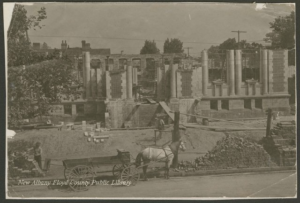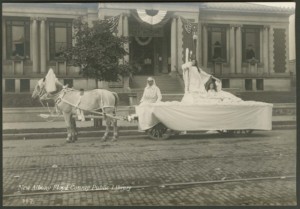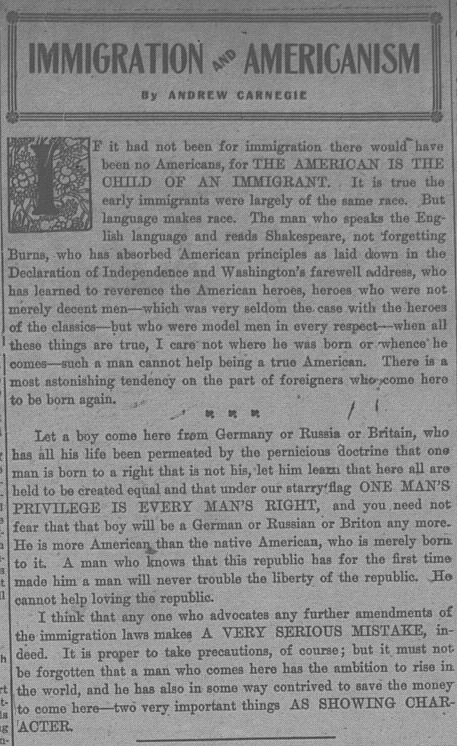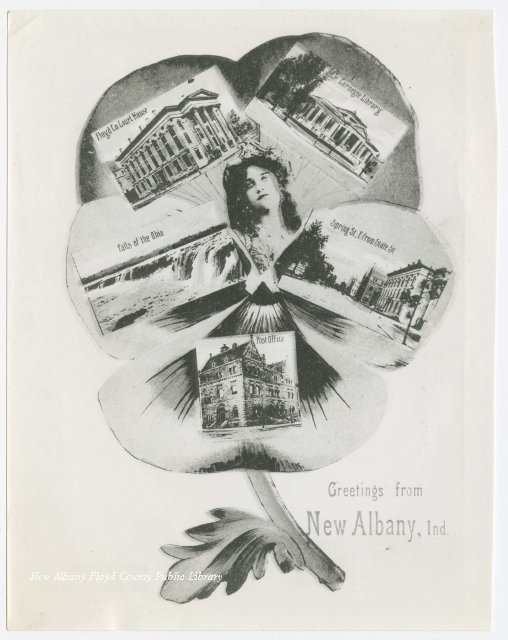As the new director of the Carnegie Center for Art and History, as well as an art historian and library lover, I was immediately attracted to the beautiful neoclassical style building which now houses a museum for art and history. Not only is the building compelling, the history behind its benefactor Andrew Carnegie intrigues me. Plus, Indiana has the highest concentration of Carnegie libraries, 164 total, of any state in the nation. These factors inspired me to plan an exhibition in 2021 on the architectural and social histories of Carnegie’s libraries in Indiana. This is just the beginning of my research.

New Albany Public Library (Carnegie Building), New Albany, Ind., 1902, Indiana History Room Archive

Centennial Parade float at the Carnegie Library, 1913, Indiana History Room Archive
Andrew Carnegie once stated that “A library outranks any other one thing a community can do to benefit its people. It is a never failing spring in the desert.” One of the most philanthropic people in history, Carnegie funded 2,509 libraries across the world, 1,689 of them in the United States alone. A Scottish immigrant who lived in Pittsburgh, Carnegie tried to petition to use his local library for free. At the time, libraries were on a subscription basis. As a textile mill worker, he could not afford the subscription, and eventually benefitted from a private library he was allowed to use. He consumed books voraciously. His appetite for books was matched only by his ambitions. By 1901, he was the world’s richest man, amassing his wealth in telegraphs, railroads, iron, and steel.

New Albany Library during the flood of 1937, Indiana History Room Archive
He gave away more than $350 million dollars in his lifetime. In 1889, he wrote in “The Gospels of Wealth,” “In bestowing charity the main consideration should be to help those who help themselves.” He viewed libraries as instruments of change in the same way that many wealthy Americans viewed art museums as arbiters of positive civic engagement to lift up the poorest people. In contrast to his extreme generosity, Carnegie could be a ruthless businessman. The
most egregious example was the Homestead Steel Strike of 1892. In a 1946 article in the Indianapolis Times, Anton Scherrer noted the conflict upon the 50th anniversary of the Indianapolis library. He wrote, “The opposition developed the minute it was learned that Mr. Carnegie’s money was
‘tainted’ because it had been acquired by monopoly, the methods
of which had reduced working men to a state of servitude.”
Ultimately, Andrew Carnegie’s legacy in libraries created a network of free and accessible knowledge across the nation. These buildings have endured, many as libraries, but others with distinct new missions, like the Carnegie Center for Art and History in New Albany. The Carnegie Center building was dedicated on February 5, 1904, designed by architect Arthur Loomis (of Speed Art Museum fame, among others). The Carnegie has been an enduring fixture of the community since 1904, first as a library until 1969, then as a museum for history and art. These images are a testament to its long history. More research coming soon!
Eileen Yanoviak, PhD
Director, Carnegie Center for Art and History
More in the archives:

Newspaper article, February 6, 1904, New Albany Evening Tribune

“Immigration and Americanism” by Andrew Carnegie, New Albany Evening Tribune, February 6, 1904

Undated postcard, “Greetings from New Albany” including the Carnegie Library

